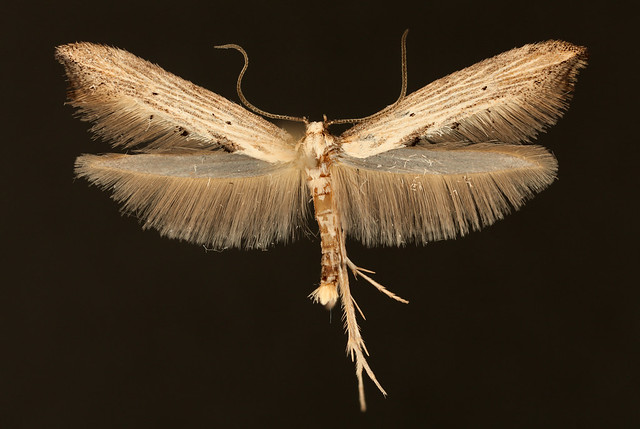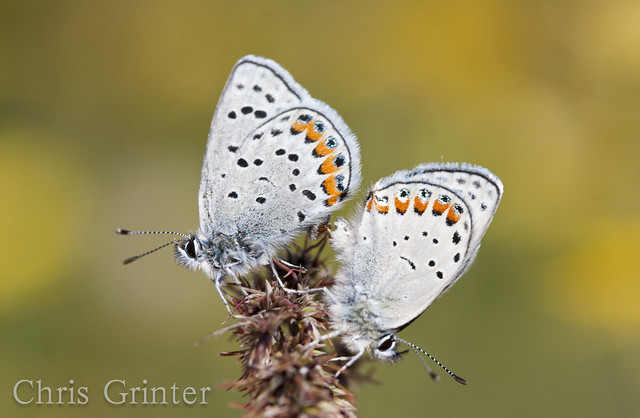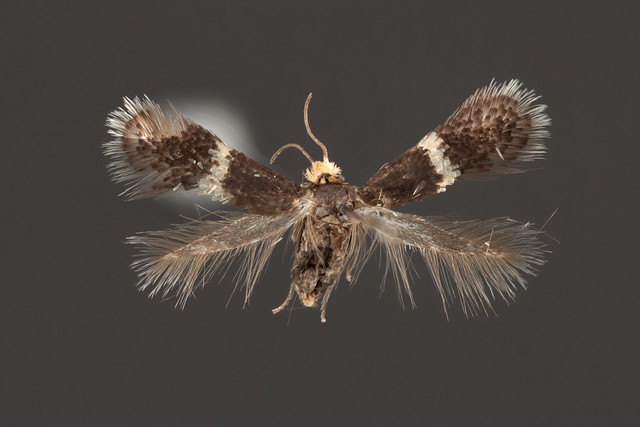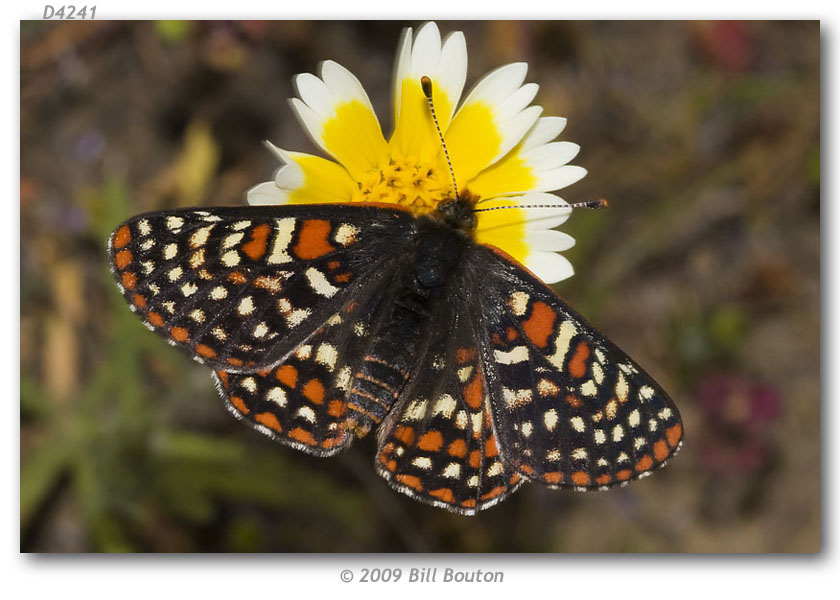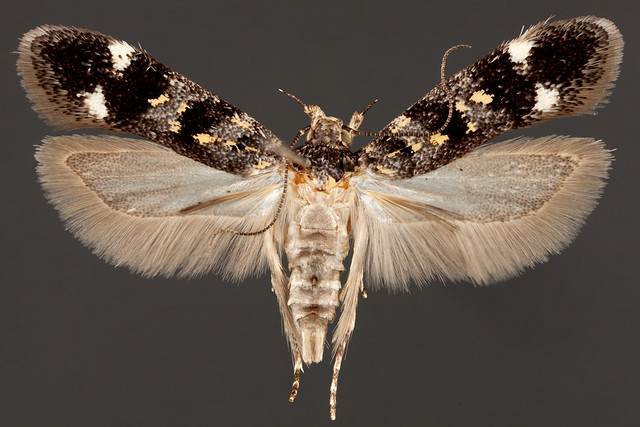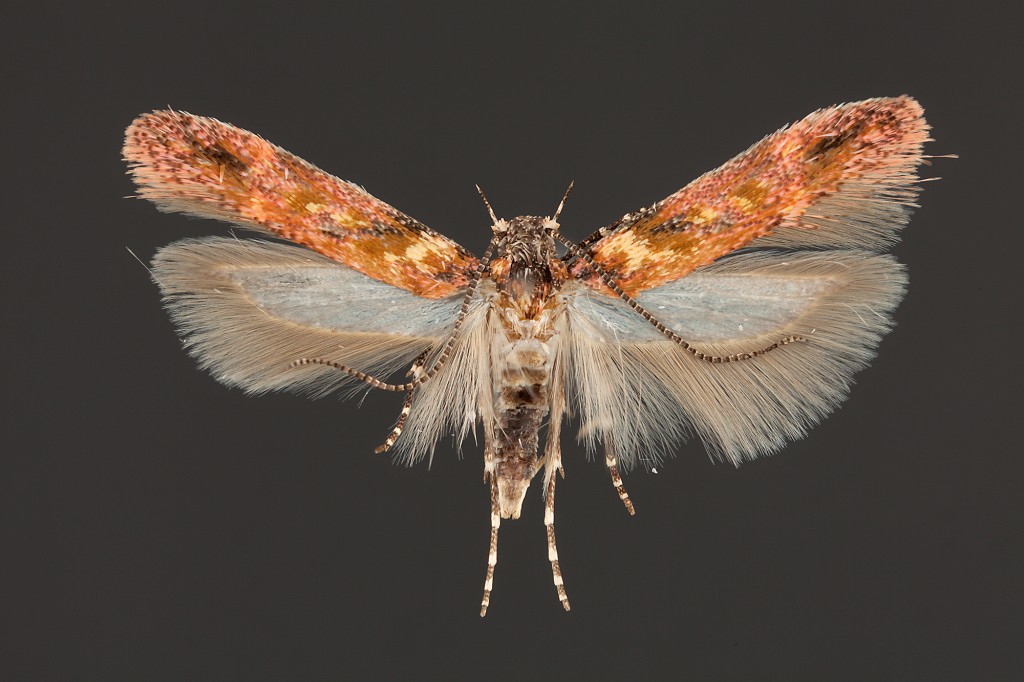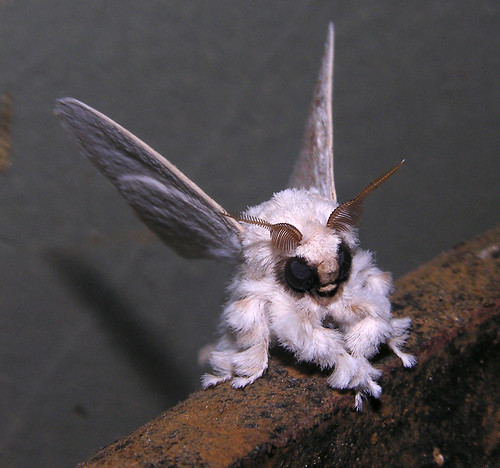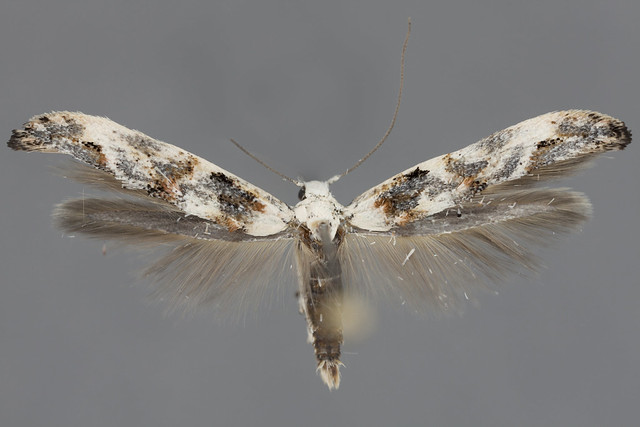Šodienas kode ir skaisti suga no Rocky Mountains ārpus Denver, Epermenia stolidota (Epermeniidae). Tas ir faktiski lielāks paraugs, nekā tas parādās, par 20 mm no wingtip līdz wingtip. Tiem, kas izvirzīti, satumsa, tufts of scales on the posterior edge of the forewing is a great character for this family, as well as the stiff bristles on the hind tibia (also somewhat visible here). Ir 11 species in 2 genera in the United States, with likely a few more to be discovered. Fellow curatorial assistant David Bettman keyed this species out using the revision of the Nearctic species: PDF here.
|
Šonedēļ es esmu dalīšanas niecīga, švaki, un daļēji kompetenti izplatīja Nepticulidae ģintī Stigmella no tās pašas Preskotas Arizonas gaismas lamatas, no kurām pēdējās pirmdienas kodes. Es parasti nebūtu dalīties fotogrāfiju kode, kas nav labākā stāvoklī, bet es to izmantoju kā tehnikas piemēru. Šis 4 mm kode tika izvilkts ne tikai no gaismas lamatas dibena, bet tas tika piesprausts uz lauka un žāvēts vairāk nekā pusotru gadu. Es vienmēr esmu dzirdējis, ka ir gandrīz neiespējami tikt galā ar mazāko no mazajiem; un lielākoties man nav. Es kādreiz domāju, ka jums tie ir jānoņem no gaišas lapas dzīvus flakonā un mirkli pirms izplatīšanas ir jānomierina., visu laiku nekad, ļaujiet tiem iepriekš nožūt vismazāk. Bet kā izrādās, ar kārtīgu eksemplāru var tikt vaļā atpūšoties 24 stundas un izplatīšanās kājām gaisā. Protams, ja jums ir pilnīgi svaigs īpatnis, kas izvairījās no blendera ar kausu, tas būtu daudz labāks paraugs.. Vēl labāk, tu izvilki lapu mīnu un pats audzēji kodes. Lielākā daļa no šiem Nepticulidae ir specifiski saimniekiem un ir daudz daudzveidīgākas, nekā mēs to esam atzinuši. Esmu dzirdējis, ka varētu būt vismaz 100 jaunas sugas, kas gaida atklāšanu tikai ASV. Stāsts par daudziem Sanfrancisko tauriņiem ir labi zināms un nomācošs. Apgabalu vairāk nekā divus gadsimtus ir smagi ietekmējusi cilvēka attīstība, un tā ir bēdīgi slavenā mājvieta pirmajam zināmajam izmiruša amerikāņu tauriņa paraugam., the Xerces zils. Kamēr citi tauriņi karājas, vai saņemt palīdzību, lai pakārtu, piemēram, Zilā misija, daži, piemēram, Bay Checkerspot, ir turpinājuši kristies, neskatoties uz drosmīgajiem centieniem atjaunot. Šodien, vienīgā zināmā Bay Checkerspot kolonija atrodas Santaklaras apgabalā vietā, ko sauc par Coyote Ridge. Tas bija divdesmit viens gads, kad slavenais biologs intensīvi pētīja dambreti 1960. un 70. gados. Pols Ērlihs kas deva stimulu iekļaušanai federālajā sarakstā 1987. Gada 1998 viņa pētītās kolonijas ir kopš tā laika izmiris. Šeit ir fragments no a 1980 rakstu žurnālā Journal of the Lepidopterists’ Sabiedrība “Divas Kalifornijas dambretes tauriņu sugas, Viens jauns, Viens uz izzušanas robežas” (.pdf).
Visi centieni pārvietot šo tauriņu ir bijuši neveiksmīgi, un šī dzīvnieka nākotne nešķiet spoža. Un kā tad īsti sauc šo radījumu? In 1937 Roberts F. Sternickis aprakstīja, viņaprāt, aizmirsto Sanfrancisko tauriņu “Euphydryas editha var. bayensis“. Šie agrīnie variāciju un rasu apraksti ir aptuveni līdzvērtīgi mūsdienu pasugām – un tā tauriņš palika bayensis gadu desmitiem un kļuva par a talismans saglabāšanai. Bet kur bija pats pirmais Euphydras editha no un kā notika Sanfrancisko bayensis atšķiras? Diemžēl sākotnējais apraksts ir neskaidrs, un savākšanas vieta ir vienkārši norādīta kā “Kalifornijā”, kā tas bija nelaimīgs ieradums Boisduval kurš aprakstīja tauriņu 1852. Bet visas cerības nav zaudētas, jo slavenais franču lepidopteris lika viņam paraugus nosūtīja agrākais Kalifornijas lepidopteris., Pjērs Džozefs Mišels Lorkins. Dedzīgs zelta meklētājs un tauriņu kolekcionārs, Lorkins ceļoja Kalifornijā no 1849 uz 1858 un atkal iekšā 1869. Katrs tauriņš, kas tika nosūtīts atpakaļ uz Franciju, bija jauna suga, un to vēlāk aprakstīja Boisduval – kurš, protams, nosauca vienu no Kalifornijas skaistākajiem tauriņiem pēc Lorkina. Ienāc Emmel, Emels un Metūns iekšā 1994 kuri rakstīja Rietumu Ziemeļamerikas tauriņu sistemātiku. Šo agrīno rietumu sugu putru sakopšanas procesā viņiem bija jānosaka Lektotips E. edita edita jo Boisduvals nekad nefiksēja holotipu 1852. Būtībā viņš nosauca jaunu sugu, nenorādot grupas taksonomisko standartu, padarot taksonomiem neskaidru turpmāko darbu. Par laimi, Lorkina ceļojumi ir aptuveni dokumentēti, un mēs varam pārliecināties, ka viņam vajadzēja atrasties Sanfrancisko ap plkst. 1849. Salīdzinot oriģinālos paraugus ar Bay Checkerspot, pārliecinoši tika konstatēts, ka tieši šis tauriņš tika nosūtīts uz Franciju 19. gadsimtā.. Tāpēc šī atraduma rezultāts novieto Bay Checkerspot Euphydryas editha bayensis sinonīmā vecākajam vārdam Euphydryas editha editha. Vārds bayensis faktiski pazuda, jo tas bija atkārtots tauriņa apraksts, kas jau bija zināms. Euphydryas e. redaktors Kā izrādās, tas ir zināms no Kalifornijas piekrastes no līča reģiona līdz Sanluis Obispo – un tā voila, tikko eksplodēja Bay Checkerspot diapazons. Bet, protams, stāsts nav tik vienkāršs, un tauriņš nekļuva maģiski drošs, mainot vārdu. Aizsardzības grupas un ekologs spārdīja un kliedza un atteicās pieņemt izmaiņas, pat Xerces biedrība nav piekritis taksonomistu vienprātībai, jo es varu tikai pieņemt, ka bailes šķiet, ka viņu tauriņš vairs nav apdraudēts. Uzsvēršu, ka tas nenozīmē, ka līča populācijas vairs nav apdraudētas – joprojām ir jāaizsargā šīs bioloģiski nozīmīgās populācijas, jo to skaits ievērojami samazinās. Visā reģionā atrodas biotopi pastāvīgi un kaitīgi draudi (pdf). Kopumā vārda maiņa ir triviāla, tagad Edītes dambrete var saukt par Bay Checkerspot, un joprojām cīnies, lai aizsargātu šo tauriņu. Es neesmu pārliecināts par to, kas būtu nepieciešams, lai grozītu federālo reģistrā, un ja vispār ir iespējams šādi paplašināt dzīvnieka aizsardzību, neatkārtojot apdraudēto sugu likumu. Tāpēc varbūt es saprotu nespēju pieņemt vārda maiņu, jo no malas izskatās, ka viņu kļūda vairs nav apdraudēta. No otras puses,, tas varētu pievērst uzmanību tauriņu populācijām, kas gadu desmitiem ir ignorētas.
Liels paldies Džonam Pelham par sarunām ar mani par šīm taksonomiskajām galvassāpēm.
Kā būtu ar citu neidentificētu Gelechiidae no tās pašas vietas, kur iepriekšējais paraugs (Nē. Preskota Arizonā). Es ķeros pie šī kožu ģints piederības Chionodes – un tas ir virspusēji līdzīgs sugai C. Turpināt. Par laimi ir šīs grupas monogrāfija (Amerikas kodes uz ziemeļiem no Meksikas, fascikulis 7.6) un es varēšu preparēt un, cerams, nonākt pie labākas identifikācijas. Kožu dzimumorgāni ir brīnišķīgi sklerotizētas struktūras, kas var nodrošināt daudzas identifikācijas zīmes.. Man noteikti drīz jāpadalās ar attēliem, kā izskatās dzimumorgāni!
This moth is a good example of what a lot of my moths are at the moment – unidentified! This is certainly a Gelechiidae, you can see the large upturned palps on the front of the head, and a finger-shaped projection on the tips of the hindwings. Just about one of the easiest families of microleps to identify. And from a general gestalt perhaps this is in the Gnorimoschemini? If someone recognizes this little guy please let me know, otherwise I’ll attack the literature to try and track down the name. This beautiful moth is from the mountains outside of Prescott, AZ – Jūlijs 2010. Rather enjoyably, there are so many microlepidoptera that are not easily identified. You may have already heard the shocking news regarding the impending changes at the Field Museum of Natural History in Chicago. Īsumā, the museum is in financial crisis and massive changes are going to be implemented by the new president, Richard Lariviere. It’s likely that up to half of the research staff (including tenured curators) will be laid off and all research departments will be dissolved into “science and education”. Money will be spent modernizing the exhibits, all while gutting the scientific core of the museum. Please take a moment to sign this petition and voice your concern: Protect Research at the Field MuseumPirms dažiem mēnešiem daudzi no jums, iespējams, stumbled visā šo même – slavenais Pūdeļu kode! Un tiešām lielākā daļa pārskatu bija puse pienācīgas. Jā, tā ir īsta. Jā, tas kode. Jā, tas ir iespējams, suga, kas Lasiocampidae (iespējams, ģints Artace) kā pareizi norādīja Dr. Džons Rolinss. Es gaidīju, ka viss būs labi un labi, hei, tur ir daudz jauku kožu, un ir pienācis laiks to kādam pamanīt! Es neuztraucos izlasīt rakstu, līdz kolēģis to man pārsūtīja no “Kosmiskā pieteikšanās vietnē nbcnews.com“. Tas, ko es atradu, bija Nav reāla kaitējuma, bet visa šī kriptozooloģijas lieta mani satrauc. Es domāju, ka ir žēl, ka kriptozoologs piesaistīja tik lielu publicitāti un par viņu runāja diezgan ticami. Kriptozooloģija ir nē zinātne, tā arī nekad nebūs. Ja kriptozooloģiju veic kā zinātni, to sauc par bioloģiju. Jā, ir neprātīgi cilvēki, kuri uzskata, ka viņi nodarbojas ar īstu zinātni, sekojot gariem stāstiem aprindās un veidojot anekdošu kaudzes “pierādījumi” kas, šķiet, nekad neizraisa patiesību. Pastāv reālas atšķirības starp to, ko dara zinātnieks un pseidozinātnieks. Pieņemsim, ka zinātnieks dzird ziņojumus par dīvainu dzīvnieku, kas dzīvo dziļos džungļos – viņi dodas ekspedīcijā (pēc finansējuma ubagošanas) veikt smago darbu, apkopojot vietējos stāstus un pārgājienus pa džungļiem vai niršanu okeānos, lai atrastu paraugus. Tad viņi tos eksemplārus nes mājās, izpētiet katru detaļu, un publicējiet rezultātus recenzējamā žurnālā. Ja neviens īpatnis netika atrasts, tad zinātnieks dodas mājās tukšām rokām un pārdomā šīs jaunās mītiskās būtnes iespējamību.. Varbūt lielāks finansējums dotu viņiem vairāk laika šajā jomā… (vienmēr atbilde, tiesības?) Bet ar to stāsts beidzas, bez pierādījumiem dzīvnieks neeksistē. Šeit kriptozooloģija atšķiras no reālās zinātnes – viņi uztver anekdotiskas pasakas kā faktu un nekad neatzīst sakāvi. Nesija pastāv tāpēc, ka cilvēki redzēt viņu. Skaidrojums, iespējams, nevar būt liels ticamāku iespēju klāsts… jo pasaule, kurā dzīvo kriptozoologs, ir mītiska un būtībā nav reāla. Labi, pietiek rēkt, cerēsim, ka ziņu ciklā nonāks vēl burvīgāki naktstauriņi! Today’s moth is a stunning micro and another creature from Barb Bartell’s back yard in the Rockies. To the best of my knowledge it’s a species of Mompha (Coleophoridae), probably claudiella,but I don’t have a positive ID on this bug yet. Once I start digging through the micros from this site there are sure to be surprises! |
Skepticisms |
